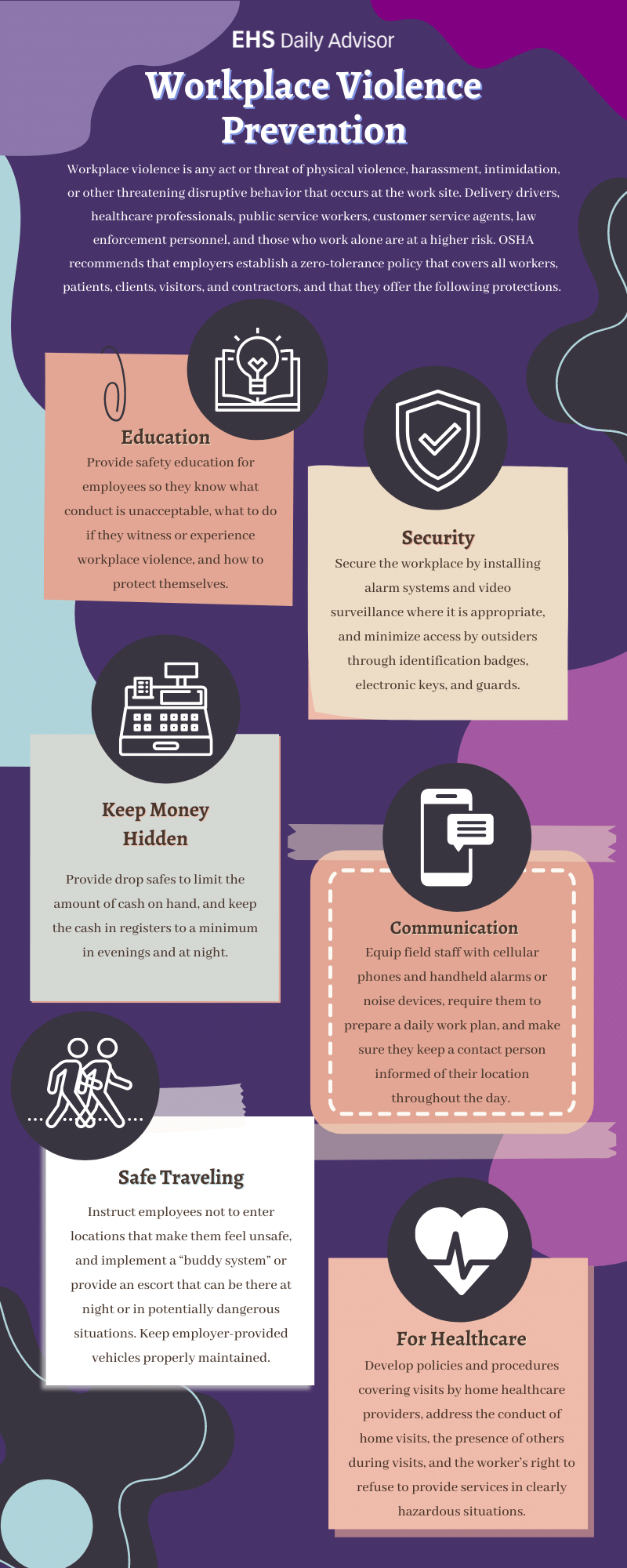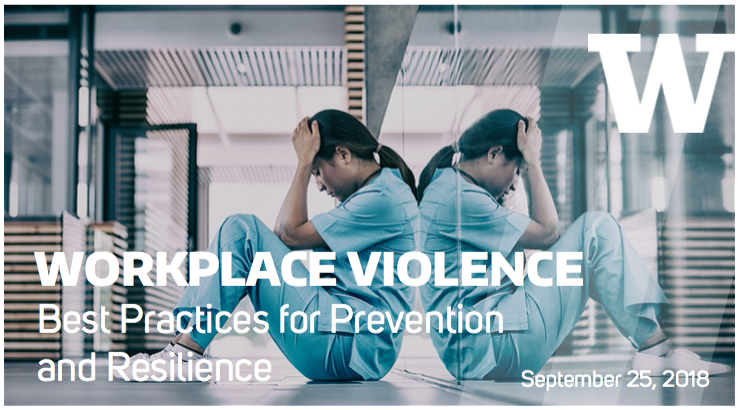A Thorough Overview to Comprehending California Workplace Violence Prevention Laws
A Thorough Overview to Comprehending California Workplace Violence Prevention Laws
Blog Article
Evaluating the Effect of Work Environment Culture on the Success of Physical Violence Avoidance Initiatives and Worker Well-Being
The junction of workplace society, violence avoidance initiatives, and worker health warrants careful exam, as these components collectively influence business success. A society that prioritizes open communication and emotional safety can encourage employees to determine and report potential dangers, thereby fostering an environment for both mental health and efficient physical violence avoidance strategies. The nuances of how these factors communicate continue to be complex and complex. Comprehending the certain mechanisms at play can reveal crucial insights that may inform future initiatives and drive purposeful change within companies. What hidden characteristics may be affecting these end results?
Recognizing Workplace Society
Frequently, workplace society offers as the foundation for worker communications and overall organizational actions. It includes the shared worths, beliefs, and techniques that form the atmosphere in which employees operate. A favorable workplace society cultivates cooperation, regard, and open communication, while an unfavorable culture might breed stress, wonder about, and hostility. Understanding workplace culture is important for companies intending to apply effective physical violence avoidance techniques.

Organizations must evaluate their existing work environment society to determine locations for improvement. This evaluation can involve surveys, emphasis teams, or one-on-one discussions. By acknowledging the cultural characteristics at play, organizations can carry out targeted interventions that advertise a more secure and more considerate job atmosphere, inevitably lowering the risk of violence in the work environment.
Role of Staff Member Health
A favorable workplace culture not just affects business habits however likewise significantly effects worker wellness. When workers feel valued and respected, their total work satisfaction increases, resulting in improved mental and psychological health and wellness. This, consequently, cultivates a feeling of belonging and commitment, which is necessary for lasting engagement and performance.
Moreover, a supportive cultural setting promotes open communication, enabling workers to look for and share issues help without fear of stigma. This openness is vital in attending to problems connected to stress and anxiety, burnout, and interpersonal problems, which can negatively impact both private health and business harmony.
Furthermore, companies that prioritize staff member well-being often see reduced absence and turnover rates. Healthy and balanced employees are extra resilient and much better furnished to handle office difficulties, adding to an extra effective and stable labor force.
Buying employee wellness with efforts such as health cares, psychological health resources, and versatile working plans can develop a positive feedback loop, improving both individual satisfaction and collective business success (california workplace violence prevention). Ultimately, focusing on employee well-being is not merely an ethical imperative; it is a critical technique that benefits the entire organization
Violence Prevention Approaches
Carrying out effective violence avoidance methods is important for preserving a healthy and balanced and safe workplace environment. Organizations has to adopt a thorough technique that consists of plan growth, worker training, and positive interaction. Establishing clear workplace physical violence plans is the primary step, ensuring that all employees recognize appropriate habits and the consequences of violations.
Training programs must be designed to inform staff members about acknowledging caution signs of potential physical violence, conflict resolution techniques, and emergency situation action procedures. Regular drills and simulations can improve preparedness, promoting a society of recognition and responsibility.
Additionally, fostering open communication networks urges workers to report worries without worry of retaliation. This can be assisted in via anonymous reporting systems or normal feedback sessions. Promoting an encouraging work environment society that values regard and inclusivity can dramatically reduce the threat of physical violence.
Organizations should likewise participate in regular analyses of their workplace society and physical violence prevention approaches, adjusting them to developing demands. By prioritizing these techniques, firms not only safeguard their staff members but likewise improve overall well-being, eventually adding to a more productive workplace.
Gauging Social Impact
Determining the impact of workplace society on violence avoidance efforts is important for recognizing the efficiency of present approaches and determining areas for renovation - california workplace violence prevention. To accomplish this, organizations must utilize a complex method that incorporates measurable and qualitative techniques. Surveys and evaluations can collect information on employee understandings of work environment safety, assistance, and inclusivity systems, while event reports offer concrete evidence of physical violence incidents and their context within the organizational culture
Additionally, focus groups and interviews can reveal much deeper insights into workers' experiences, perspectives, and beliefs surrounding violence avoidance initiatives. Evaluating this qualitative information assists organizations to identify cultural strengths and weak points that might either facilitate or impede reliable prevention strategies. Furthermore, benchmarking versus market criteria enables for relative analysis, assisting companies determine their performance about peers.

Developing Supportive Environments
Regularly fostering an encouraging atmosphere within the workplace is crucial for reliable physical violence avoidance. Such environments equip staff members to connect honestly about their issues and experiences, consequently determining possible issues before they escalate. A culture of support boosts trust amongst group participants, encouraging partnership and aggressive wikipedia reference problem-solving.
To develop an encouraging atmosphere, companies should prioritize training programs that concentrate on conflict resolution, emotional intelligence, and energetic listening. These abilities gear up workers to take care of social relationships constructively, minimizing the chance of misconceptions that might bring about physical violence - california workplace violence prevention. Additionally, implementing mentorship programs can give staff members with advice and reassurance, contributing to their general well-being
Leadership plays a crucial role fit an encouraging workplace society. By modeling understanding actions and showing a commitment to employee well-being, leaders established a tone that urges others to do the same. Regular feedback systems, such as anonymous studies, can also help evaluate staff member belief and highlight areas for improvement.
Inevitably, a supportive environment not just minimizes the risk of physical violence but likewise enhances employee spirits, task contentment, and efficiency, reinforcing the organization's dedication to fostering a thriving and risk-free office.
Final Thought
A positive office culture substantially affects both physical violence prevention initiatives and staff member health. By cultivating open interaction and urging the reporting of issues, organizations can boost mental wellness and job complete satisfaction among employees.
The intersection of workplace society, physical violence avoidance initiatives, and worker well-being warrants cautious evaluation, as these elements collectively affect organizational success. A society that focuses on open interaction and emotional safety and security can click here for more empower workers to recognize and report potential threats, consequently promoting an atmosphere conducive to both mental wellness and reliable violence prevention methods.A favorable work environment society not only affects business behavior yet likewise dramatically impacts worker wellness. Analyses and surveys can collect information on worker perceptions of office safety and security, assistance, and inclusivity systems, while case records give concrete proof of violence events and their context within the business society.
A favorable office society dramatically affects both violence avoidance initiatives and worker health.
Report this page